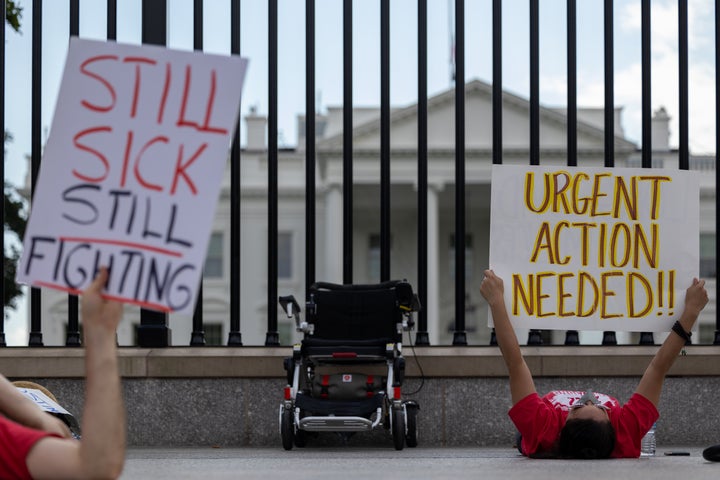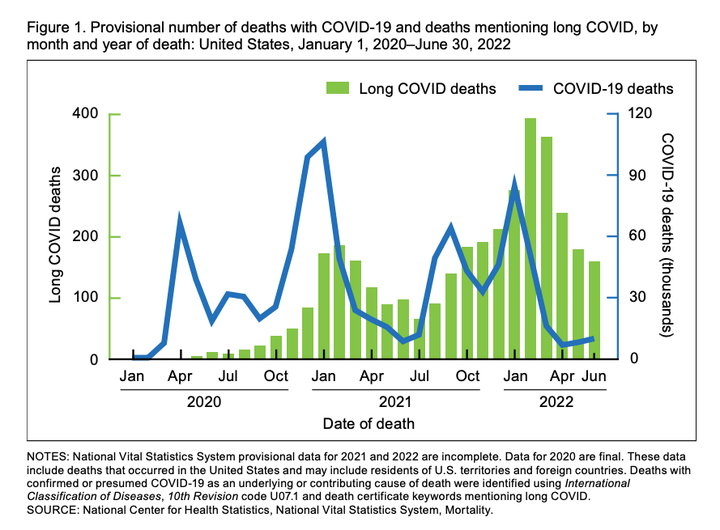Long-COVID has been linked to more than 3,500 deaths in the U.S. since the start of the coronavirus pandemic, according to data released Wednesday by the Centers for Disease Control and Prevention (CDC).
An analysis of death certificates between January 2020 and the end of June 2022 found long-COVID listed as either an underlying or a contributing cause of death among 3,544 individuals, according to the findings by the CDC’s National Center for Health Statistics.
The researchers combed the death certificates for keywords that included “chronic COVID,” “long COVID,” and “long haul COVID” to identify the related deaths. It was the CDC’s first attempt at quantifying long-COVID deaths using national vital statistics.

They found that most long-COVID-related deaths were among adults aged 75–84 and non-Hispanic white people, which made up 78.5 percent of the cases. The long-COVID death rate was highest among non-Hispanic American Indians and Alaska Natives, at 14.8 per 100,000 people.
In comparison, most people killed by COVID-19 have been slightly younger, aged 65-74, and there have been more deaths among non-Hispanic Blacks and Hispanics than non-Hispanic whites.
The researchers suggested that fewer non-Hispanic Blacks and Hispanics may have died from long-COVID issues than COVID-19 because of the virus’ high mortality rate among these racial groups, “resulting in fewer COVID-19 survivors left to experience long COVID conditions.”
“Low rates of long COVID among non-Hispanic Black and Hispanic people may also be due to poor access to health care and appropriate diagnosis and reporting of post-COVID conditions in these populations,” the report states.

The total long-COVID deaths, though significant, represented just 0.3 percent of the 1,021,487 COVID-19 deaths reported during the two-and-a-half-year period studied.
Health experts not involved in the study told The New York Times that the 0.3 percent count is likely underestimated due to the delay in medical workers recognizing and identifying long-COVID during the pandemic.
The most long-COVID-related deaths were in February 2022, while the most COVID-19 deaths were in January 2021, according to the report.
“This is just scratching the surface — this is a first look,” David Putrino, the director of rehabilitation innovation for the Mount Sinai Health System in New York, told The Times.
The report acknowledged similar limitations in its findings, including that some data may change as information is updated and additional information is received.
It also noted that death rates for some racial groups have been underestimated or overestimated due to misclassification on death certificates and that the study may not have included all key terms that identify long-COVID deaths. Some long-COVID deaths may have also been missed in the count because prior COVID-19 infection had not been confirmed or suspected.
Anyone infected with the coronavirus ― even with a mild illness or no symptoms — can experience post-COVID conditions. However, there’s a higher risk of having had severe COVID-19 illness, according to the CDC.
The complex can last months or longer and affect virtually every organ system. Some symptoms include respiratory, heart, neurological, and digestive symptoms.
The researchers hope that death certifiers will come to understand better the key terms used to describe long-COVID so that the deaths are more accurately reported. This would help more accurately quantify new and emerging public health concerns.
“There is no test to diagnose post-COVID conditions, and people may have a wide variety of symptoms that could come from other health problems. This can make it difficult for healthcare providers to recognize post-COVID conditions,” the CDC’s website notes.

